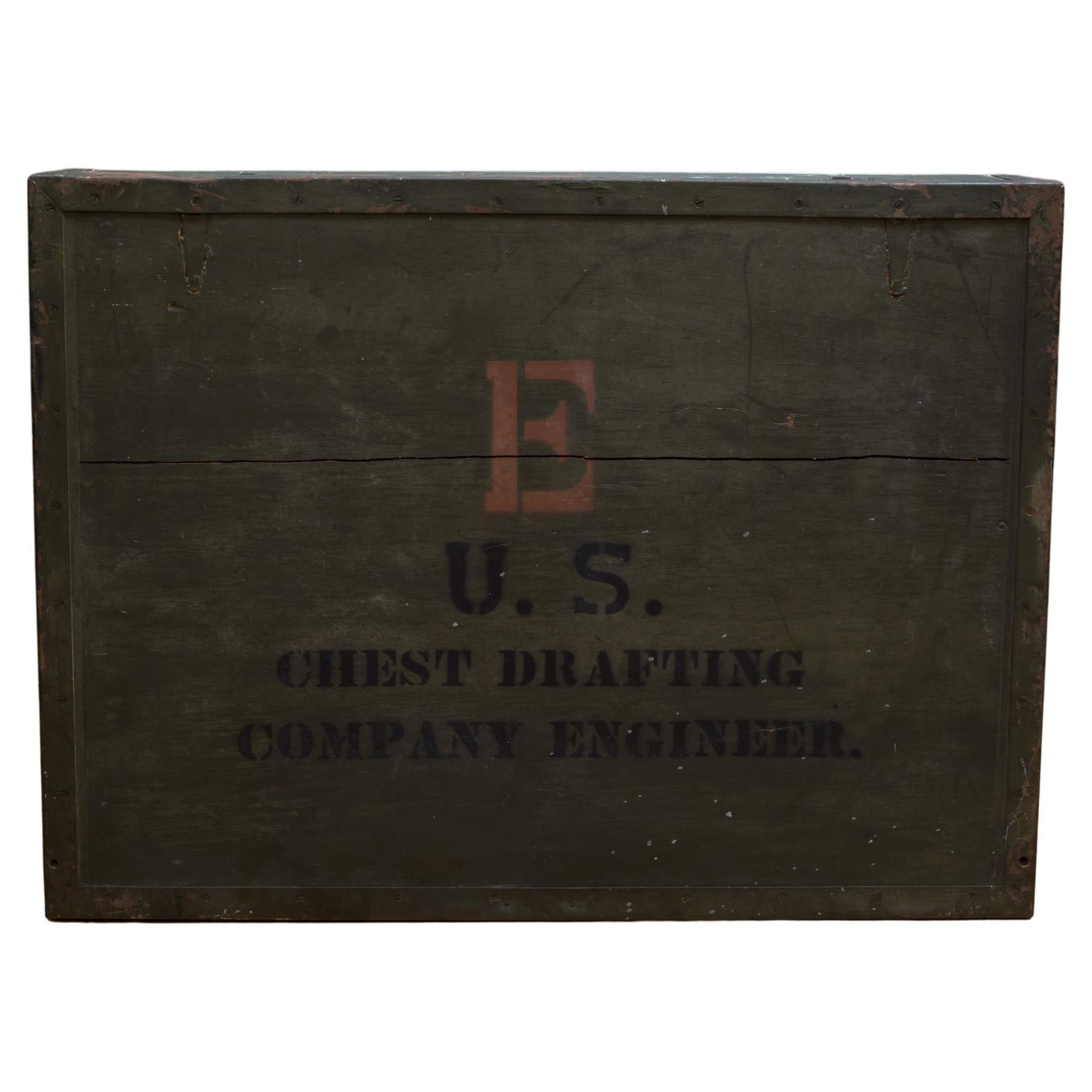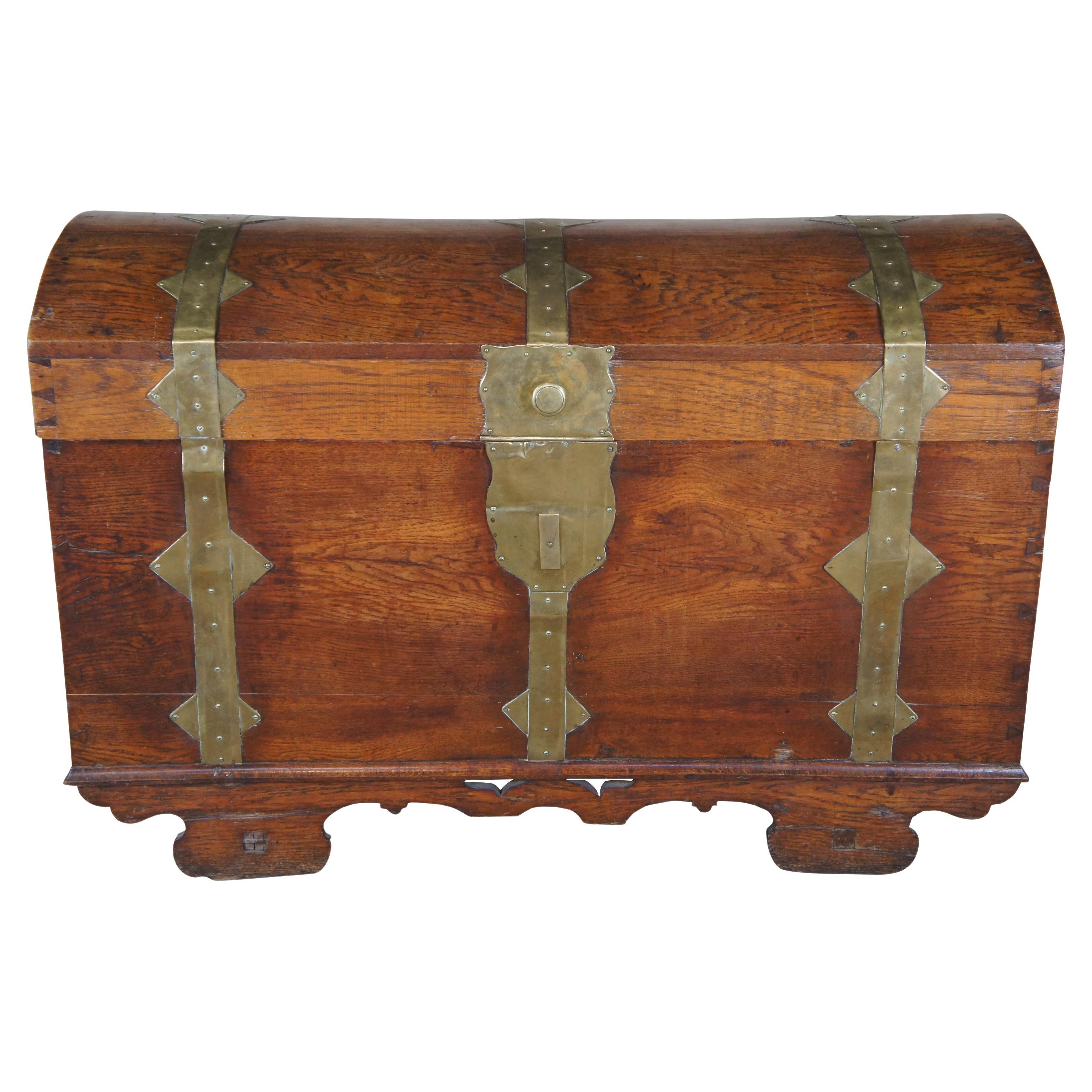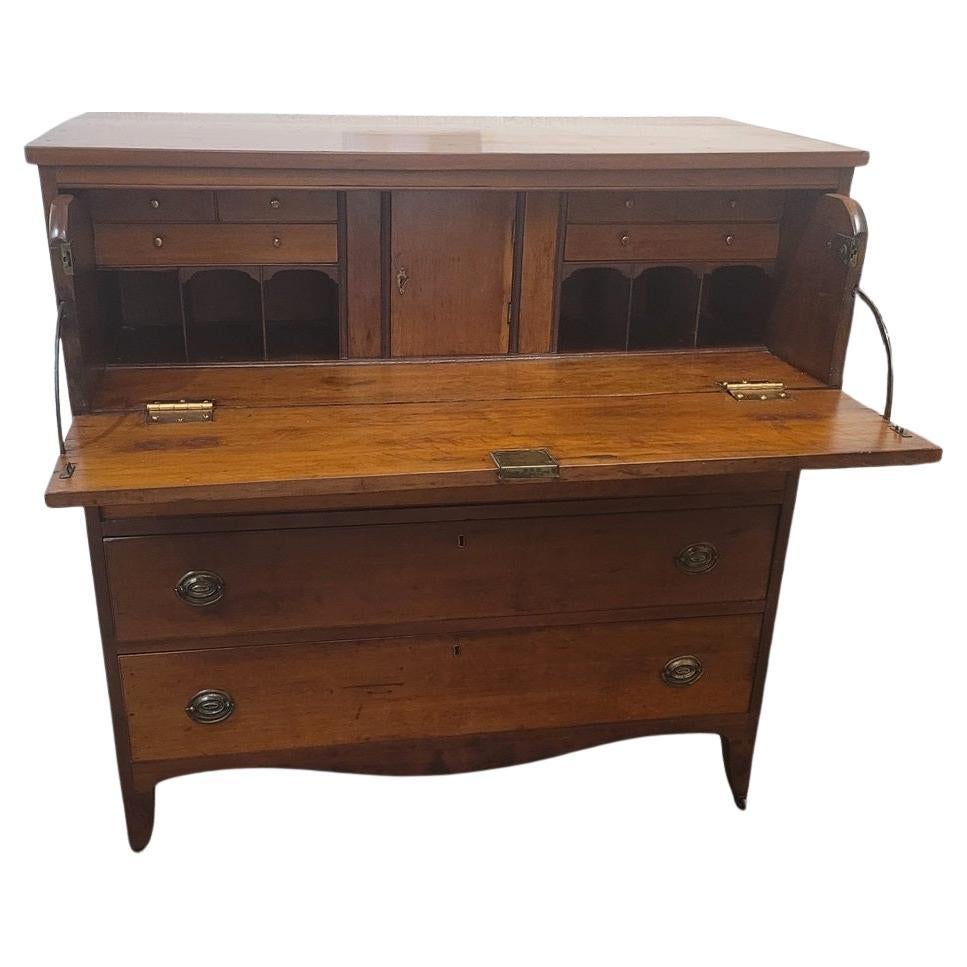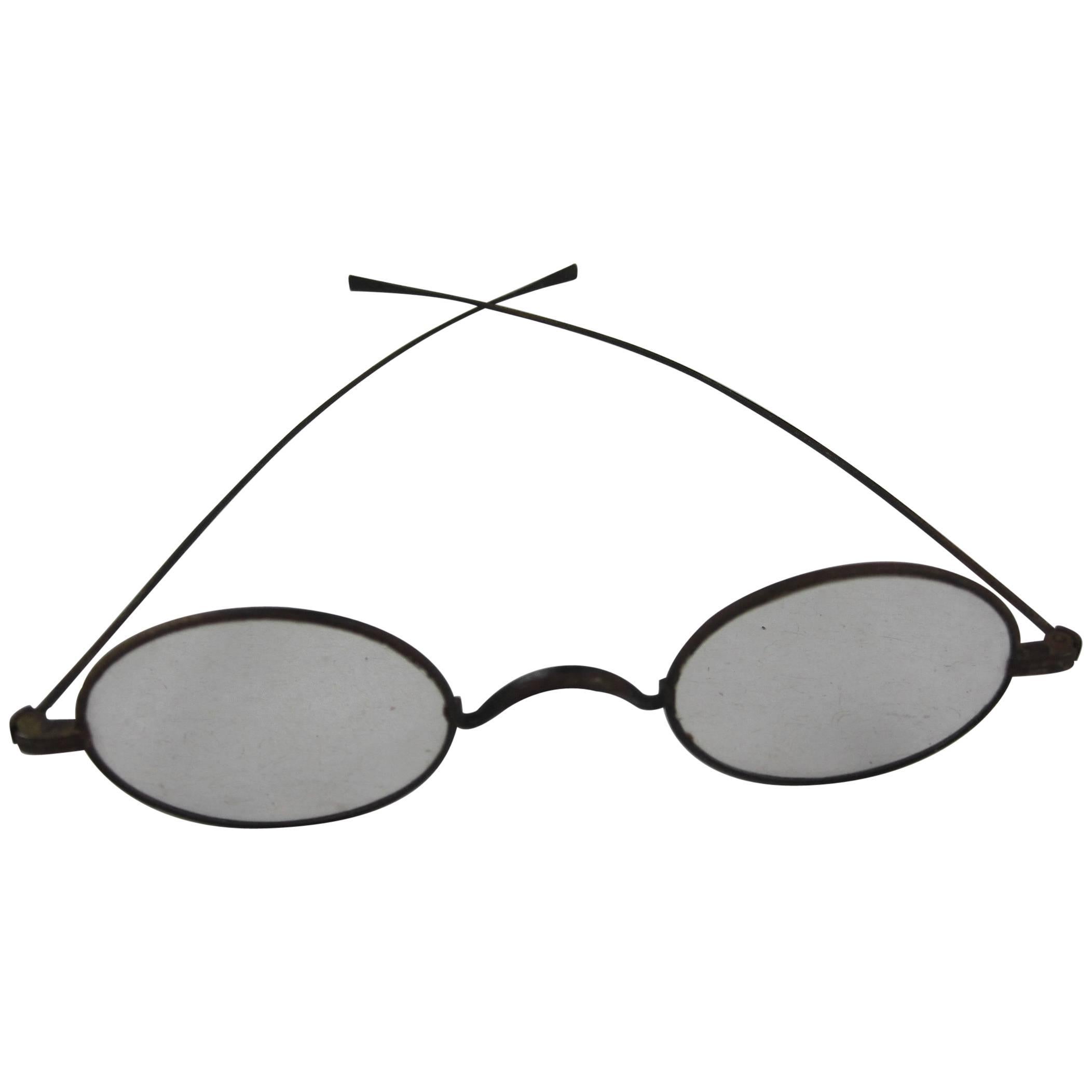Items Similar to American Civil War Era Barrel Top “Hope Chest”
Want more images or videos?
Request additional images or videos from the seller
1 of 13
American Civil War Era Barrel Top “Hope Chest”
About the Item
Circa 1860-1870’s this antique wooden chest is a real treasure. Handcrafted of red pine native to the east coast of North America, this piece originates from the time of the American Civil War (1861-1865). Wrought iron hinges and studded tacks add timeless character to this wonderfully preserved piece of history. Lined with a hard-stock floral covering on the inside, which could easily be removed, it’s ready to accommodate virtually all your storage needs.
Its substantial size makes it an excellent choice to use as a coffee or end table, which could conveniently store your collection of games/books and other accessories inside as well. Topping it with a tray can provide even more convenience and functionality. Whether it finds its home at the foot of your bed, storing extra blankets and linens in the guest room, or in the sitting room serving tea, it’s sure to be an interesting conversation piece that will add a touch of old-world style and ambiance to any space.
An incredible opportunity to own a truly one-of-a-kind piece of revolutionary history, lending tribute to American patriotism. Still surviving at 150 years old this antique chest is in great condition with wear commiserate with age. Some missing tacks have previously been replaced. Please examine photos carefully for details.
- Dimensions:Height: 24.5 in (62.23 cm)Width: 25.5 in (64.77 cm)Depth: 30 in (76.2 cm)
- Style:American Colonial (Of the Period)
- Materials and Techniques:
- Place of Origin:
- Period:
- Date of Manufacture:1860
- Condition:Wear consistent with age and use. No modifications to wood or wrought iron hinges. Only missing tacks have previously been replaced.
- Seller Location:Middletown, MD
- Reference Number:1stDibs: LU8412237388652
About the Seller
No Reviews Yet
Vetted Seller
These experienced sellers undergo a comprehensive evaluation by our team of in-house experts.
1stDibs seller since 2023
- ShippingRetrieving quote...Ships From: Middletown, MD
- Return PolicyA return for this item may be initiated within 3 days of delivery.
More From This SellerView All
- A Pair of White Agate Horse Figurehead BookendsLocated in Middletown, MDA stunning pair of exquisitely hand-carved figurehead bookends sculpted from a singular piece of authentic Mexican white agate, beautifully grained and wonderfully preserved. Prize...Category
Vintage 1920s Bookends
MaterialsAgate
- "Sweetheart" Handmade Solid Wood Doll HighchairLocated in Middletown, MDHeirloom quality solid wood doll highchair handmade in Lancaster, PA circa 1940 of native pine. Tray moves easily upon raising and lowering. Legs are sturdy and presents beautifully...Category
Mid-20th Century American American Colonial Toys and Dolls
MaterialsPine
- Heirloom Doll Size Colonial Style Solid Wood Schoolhouse DeskLocated in Middletown, MDHandmade in Lancaster, Pennsylvania circa 1940 of native pine. An adorable replica of what was typically found in school houses throughout colonial times. In good condition with mi...Category
Mid-20th Century American American Colonial Toys and Dolls
MaterialsPine
- 20th Century Impressionist Floral Still Life - SignedLocated in Middletown, MDOriginal oil painting on canvas, professionally framed. Rich, vibrant color scheme showcased in a traditional custom golden frame. Artwork is in great vintage condition and arrives r...Category
Mid-20th Century Dutch Expressionist Paintings
MaterialsCanvas, Paint
- Distressed Antique White Mid-19th Century English Country Farmhouse MirrorLocated in Middletown, MDOffering a large antique Victorian style farmhouse mirror circa 1840 with painted giltwood frame measuring nearly 4 feet in length. Mirror glass and p...Category
Antique Mid-19th Century English Victorian Wall Mirrors
MaterialsMirror, Wood
- 19th Century Brass Candlestick Table LampLocated in Middletown, MDOffering a late 19th century cast brass Rococo style candlestick lamp, circa 1890-1900, featuring a scrolling column form with elaborate, symmetrical details indicative of the Victor...Category
Antique Late 19th Century English Rococo Table Lamps
MaterialsBrass
You May Also Like
- World War 2 Era Military Trunk, c.1940Located in San Francisco, CAAbout A World War 2 era Army military trunk with original stenciled graphics on top, label and hinged lid. Army green with black and brick red stencil. ...Category
Early 20th Century Trunks and Luggage
MaterialsAluminum
- 36 Star American Flag, Civil War Era, Nevada StatehoodLocated in York County, PA36 Stars In The "Great Star" Or "Great Luminary" Pattern On A Civil War Era Flag With A Dusty Blue Canton And A Section Of One Stripe Souvenired, 1864-67, Nevada Statehood 36 star American national flag of the Civil War era, entirely hand-sewn and with some rare and beautiful features. The stars are arranged in a rendition of what is known as the Great Star or Great Luminary configuration, a large star made out of smaller stars. With no official star pattern before 1912, their design was left up to the artistic liberties of the flag-maker. Strikingly visual, the Great Star is both scarce and coveted by collectors. The 36th state, Nevada, entered the Union during the Civil War on October 31st, 1864. The last Confederate general surrendered on May 26th, 1865. The 36 star flag became official on July 4th of that year, but makers of printed flags would have begun adding a 36th star to their flags in 1864, even before the addition of the new state occurred. Lincoln pushed Nevada through just 8 days before the November election. Nevada’s wealth in silver was attractive to a nation struggling with the debts of war and increased support for the Republican ticket. The 36 star flag was replaced by the 37 star flag in 1867, with the addition of Nebraska. Adding to the flag's appeal is its small scale across those with of piece-and-sewn construction. During the 19th century, sewn flags (as opposed to those that were printed on cloth) were typically eight feet long and larger. This is because they were important in their function as signals, meaning that they needed to be seen and recognized from great distance. A flag that was six feet in length was considered small and production of flags smaller than this was extremely limited. Even infantry battle flags were approximately six by six and-one-half feet, about the size of an average quilt of the same period. As time passed, circumstances changed and sewn flags began to find more of a decorative purpose. Smaller flags are more scarce and far easier to frame and display. The Great Star configuration appears to have come about shortly after the War of 1812, when Congressman Peter Wendover of New York requested that Captain Samuel Reid, a War of 1812 naval hero, create a new design that would become the third official format of the Stars & Stripes. A recipient of the Congressional Medal of Honor, Reid became harbor master of New York following the war. During his lifetime, he created many innovations in signal use, including a system that could actually send messages from New York to New Orleans by sea in just two hours. Use as a Naval signal had been the primary reason for the initial creation of an American national flag in 1777, but since there was no official star design, the appearance of our flag varied greatly. Reid’s primary concern centered on both consistency and ease of recognition. His hope was as more and more states joined the Union and more and more stars were added to the flag, that it would remain easily identified on the open seas. In 1818, Reid suggested to Congress that the number of stripes permanently return to 13 (reduced from 15) and that the stars be grouped into the shape of one large star. Reid’s proposal would have kept the star constellation in roughly the same format, in a pattern that could be quickly identified through a spyglass as the number of states grew. His concept for the stripes was ultimately accepted, but his advice on the star pattern was rejected by President James Monroe, due to the increased cost of arranging the stars in what would become known as the “Great Star”, “Great Flower”, or “Great Luminary” pattern. Monroe probably didn’t wish to impose this cost on either the government or civilians, so he suggested a simple pattern of justified rows. Never-the-less, the Great Star was produced by anyone willing to make it and its rarity today, along with its beauty, has driven the desirability of American flags with this configuration. The canton and stripes of the flag are made of fine merino wool. Note how the canton has faded to a dusty seafoam blue, which is endearingly attractive. The stars of the flag are hand-sewn and single-appliquéd. This means that they were applied to one side of the canton, then the blue fabric was cut from behind each star, folded over, and under-hemmed, so that one star could be viewed on both sides of the flag. I always find single-appliquéd stars more interesting, not only because they are evidence of a more difficult level of seam-work and stitching, but also because they are more visually intriguing. The two visible rows of hand-stitching emphasize their hand-sewn construction, which is one reason why flags with single-appliquéd stars often appeal to connoisseurs of early American textiles...Category
Antique 1860s American Political and Patriotic Memorabilia
MaterialsWool
- Antique 18th Century Baroque Oak Brass Dome Top Hope Chest Trunk Coffer Box 49"Located in Dayton, OHAn extraordinary and extremely rare primitive early 18th Century Baroque trunk or chest. Made of oak featuring a domed top with brass bound hardware and pegged wood wheels...Category
Antique 18th Century Baroque Trunks and Luggage
MaterialsBrass
- American Hepplewhite Virginian Secretary Chest with Civil War ProvenanceBy George HepplewhiteLocated in Dallas, TXPRESENTING a FANTASTIC and HISTORIC Early 19C American Hepplewhite Virginian Secretary Chest with OUTSTANDING Provenance. This Secretary Chest was made in Virginia in the Early 19th Century, circa 1810. It is made of cherry, walnut and maple and is most definitely in the Hepplewhite Style of the period, with it’s original Hepplewhite brass drawer pulls. IT IS A REALLY INTRIGUING AND HISTORIC PIECE, ESPECIALLY, WHEN VIEWED IN CONTEXT WITH IT”S AMAZING PROVENANCE! This piece was originally owned by Major William Alexander Obenchain who ‘hailed’ from the State of Virginia. He was an engineer and was in the Virginia Corps of Engineers during the Civil War and served on General Robert E. Lee’s staff. It was acquired by him before the Civil War and we believe that this piece was on campaign with him during the War. We know for a fact that he fought at the Richmond Campaign in 1864, as we have, in our Collection, his original Field Map for that Campaign which ended the War. It has remained in family ownership ever since. It has come directly from the Family Estate, together with other VERY IMPORTANT items belonging to Major Obenchain and other IMPORTANT items that belonged to his wife, Eliza Calvert Hall-Obenchain. ALL these items contained in the Collection, are listed/posted individually on our Website. The top drawer is on retractable curved side hinge supports and pulls outwards and drops to reveal a secretary and writing area. The Bureau/Secretary Gallery has 6 drawers and 6 cubbies, a central tabernacle door with another drawer and 2 cubbies and this is flanked by 2 secret pull out compartments. The central tabernacle door has it’s original key and working lock. Closed, it is almost ‘flush’ like the rest of the drawers, with some very minor bowing through age. The 3 drawers underneath are graduated in size and it ends with a serpentine shaped base and sits on four hand carved legs with original metal casters, marked ‘Universal 3’. It has it’s original brasses and hardware throughout, save the addition to 2 contemporary replacement brass hinges to the drop down desk front, as the original hinges were broken, could not be repaired and were not supporting the weight of the drop down leaf. Some minor repairs but not noticeable. Otherwise, the piece is in it’s entirely, ORIGINAL condition! What makes this piece even MORE INTRIGUING and APPEALING HISTORICALLY, are the 2 ‘historic’ circular holes on the piece:- (1) in the back of the piece as seen in the photos. This hole is not symmetrical or fully round and appears to serve no purpose to the piece whatsoever. Sometimes, pieces have holes for wiring for lighting, put in them over the years, but this one never had such lighting or, indeed, any such explanation for this hole, AND (2) the rear hole is replicated, in the corner portion of the bottom drawer and someone (a very long time ago) has used a tin can top, to cover the hole in the back of the drawer. The tin can top is period to the Civil War Era and is embossed “Minimum Volume 1 Pint”. Our conclusion, is that (whilst we are, by no means ballistic experts) that these holes were created by musket balls, fired during one of the Major’s campaigns in the Civil War. It is entirely conceivable that this piece, being strapped into a covered wagon for carriage, would have been on it’s side. We are of the opinion that both holes, were caused or created by a musket ball entered the chest trough the base and back. We also believe that ‘the Major’, used what he had at his disposal on the battlefield, namely, a tin can lid to repair the hole in the drawer. SO THIS PIECE IS A VERY SPECIAL PIECE OF US HISTORY, INDEED! NOT ONLY IS IT AN EARLY 19th CENTURY AMERICAN PIECE, WITH A CONNECTION TO THE STATE OF VIRGINIA, THE CIVIL WAR, HISTORIC & IMPORTANT FIGURES IN THAT WAR AND IMPECCABLE PROVENANCE AND HISTORY! IT IS TRULY UNIQUE! William Alexander Obenchain. Born April 27, 1841 at Buchanan, Botetourt Co., Virginia. Parents: Thomas Jefferson Obenchain and Elizabeth Ann Sweetland. Entered VMI on July 18, 1859 as a member of the VMI (Virginia Military Institute...Category
Antique Early 19th Century American American Classical Historical Memora...
MaterialsBrass
- Historical American Civil War Era Wire Frame Magnifying Eye Glass SpectaclesLocated in Philadelphia, PAA delicate pair of handmade magnifying wire rim eye glasses from the American Civil War era, circa 1860. A great looking historical conversation p...Category
Antique Mid-19th Century American American Classical Historical Memorabilia
MaterialsMetal
- Delightful Antique Painted Hope Chest with Handpainted Dutch FiguresLocated in Hopewell, NJA wonderful folk art hand painted antique trunk or chest in a yellow gold having charming male and female Dutch peasants adorning the top. Great size fo...Category
Antique Early 1900s North American Folk Art Trunks and Luggage
MaterialsWood
Recently Viewed
View AllMore Ways To Browse
Hulbert Bros
Pineider Leather
Louis Vuitton 3 Piece Bag Mens
Alzer 80
Louis Vuitton Alzer 80
Louis Vuitton Hats Womens
Attache Case Louis Vuitton
Collection Of Vintage Suitcases
Fpm Milano
Gladstone Bag Used
I Got A Louis Vuitton
Lille Louis Vuitton
Louis Vuitton Attache Case
Louis Vuitton Bed Cover
Louis Vuitton Bracket
Louis Vuitton Brackets
Louis Vuitton Courrier Trunk
Louis Vuitton Drill





